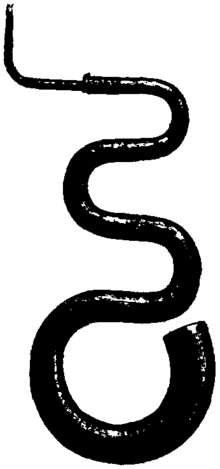Alto recorder

| Musical instruments |
|---|
Woodwinds
|
| Brass |
| Percussion |
| String instruments |
| Keyboards |
The alto recorder in F, also known as a treble (and, historically, as consort flute and common flute) is a member of the recorder family. Up until the 17th century the alto instrument was normally in G4 instead of F4 (Lasocki 2001, (ii) Renaissance; Sachs 1913, 50).
The alto is between the soprano and tenor in size, and is correspondingly intermediate in pitch. It has the same general shape as a soprano, but is approximately 50% larger in all dimensions. A 50% increase in length causes a 50% increase in the wavelength for a given fingering. This lowers the pitch by a perfect fifth, that is from C to F.
The F alto is a non-transposing instrument, though its basic scale is in F, that is, a fifth lower than the soprano recorder and a fourth higher than the tenor (both with a basic scale in C). So-called F fingerings are therefore used, as with the bassoon or the low register of the clarinet, in contrast to the C fingerings used for most other woodwinds. Its notation is usually at sounding pitch, but sometimes is written an octave lower than it sounds.
For adult hands, the alto recorder is easy to play. Maintenance is the same as for the soprano recorder.
History
Recorders are known to have been made in different sizes since at least the 15th century, but a consistent terminology did not exist until the 20th-century revival of the instrument. In the early 16th century, books were published by Sebastian Virdung (1511), Martin Agricola (1529), and Sylvestro Ganassi (1535), all of which describe the smallest of three sizes of recorder (tuned in fifths) as an instrument with the bottom note G. Appropriate to the highest instrument of the set, it is given a name used for the highest vocal part in music from that time: discant (Virdung 1511, fol. N1r; Agricola 1529, fol. 6v, Virdung also calls it clain flöte—"small flute", kleine Flöte in modern German) and sopran or soprano (Ganassi 1535, fol. 2v). At this time, recorders were made in a single piece. This type of instrument continued to be produced through the 17th century and into the early 18th, though around 1650 it began to be made in three separate parts. It was sometimes called the flauto italiano, particularly after about 1670 when a new type of recorder appeared in France, called flûte douce (sweet flute), what today would be called an alto (treble) in F. In contrast to the bright-toned flauto italiano, which was easy to play in the high register, the flüte douce was full and resonant in the low register, but was weak on the upper notes. This new version of recorder (first depicted in a painting from 1672) was first made in Paris and, shortly later and under French influence, in London. The redesign is traditionally attributed to the Hotteterres, particularly to Jean Hotteterre, though the evidence is rather tenuous. In 1696, Johann Christoph Denner and Johann Schell applied for permission to make the French type of instrument in Nuremberg, and it quickly became the dominant type of instrument across Europe. In most languages, this was the instrument meant by the word for flute alone: German Flöte, Dutch fluyt, Italian flauto, Spanish flauta. In England, it was usually simply "flute", but when necessary to differentiate from the transverse flute or other sizes of recorder, it was called "common flute" or "consort flute" (Lasocki 2001).
References
- Agricola, Martin. 1529. Musica instrumẽtalis deudsch ynn welcher begriffen ist/ wie man nach dem gesange auff mancherley Pfeiffen lernen sol/ Auch wie auff die Orgel/ Harffen/ Lauten/ Geigen/ vnd allerley Instrument vnd Seytenspiel/ nach der rechtgegründten Tabelthur sey abzusetzen. Wittemberg: Georg Rhaw.
- Baines, Anthony C. 1967. Woodwind Instruments and Their History, third edition, with a foreword by Sir Adrian Boult. London: Faber and Faber. Reprinted with corrections, 1977. This edition reissued, Mineola, New York: Dover Publications, Inc., 1991, and reprinted again in 2012. ISBN 978-0-486-26885-9.
- Ganassi, Sylvestro da Fontego. 1535. Opera intitulata Fontegara. Venice: [s.n.]. Facsimile reprint, Collezione di trattati e musiche antiche edite in fac-simile. Milan: Bollettino bibliografico musicale, 1934. Facsimile reprint, edited by Luca de Paolis. Hortus Musicus, Prattica di musica, Serie A 3. Rome: Società italiana del flauto dolce, 1991. Facsimile reprint of the second edition, 1542, Bibliotheca musica Bononiensis 2:18. Bologna: Arnaldo Forni Editore, 1969, reprinted again in 1980 and 2002.
- Griscom, Richard W., and David Lasocki. 2013. The Recorder: A Research and Information Guide, third edition. Routledge Music Bibliographies. Routledge. ISBN 978-1-135-83932-1.
- Hunt, Edgar. 1988. "Syntagma Musicum II, Parts 1 and 2 of De Organographia by Michael Praetorius; David Z. Crookes" (review). The Galpin Society Journal 41 (October): 142–44.
- Lasocki, David. 2001. "Recorder". The New Grove Dictionary of Music and Musicians, second edition, edited by Stanley Sadie and John Tyrrell. London: Macmillan Publishers.
- Praetorius, Michael. 1619a. Syntagmatis Musici Michaelis Praetorii C. Tomus Secundus De Organographia. Wolfenbüttel: Elias Holwein, in Verlegung des Autoris.
- Praetorius, Michael. 1619b. Syntagmatis Musici Michaelis Praetorii C. Tomus Tertius. Wolfenbüttel: Elias Holwein.
- Sachs, Curt. 1913. Real-Lexikon der Musikinstrumente, zugleich ein Polyglossar für das gesamte Instrumentengebiet. Berlin: Julius Bard.
- Virdung, Sebastianus. 1511. Musica getutscht und ausgezogen. Basel: [s.n.]. Facsimile reprint, edited by Klaus Wolfgang Niemöller. Documenta musicologica 31. Kassel: Bärenreiter, 1970. ISBN 3-7618-0004-5.
- Virgiliano, Aurelio. c.1600. Il dolcimelo. Manuscript. Bologna: Civico Museo Bibliografico Musicale. Facsimile edition, edited by Marcello Castellani. Archivum Musicum: Collana di testi rari 11. Florence: Studio per Edizioni Scelte. 1979.
